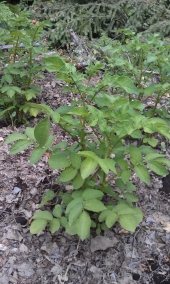




















Longsnowsm wrote:
I realized I forgot to post the info on the book. You should be able to find it with the following info if your interested in a snapshot in time....
Gardening for Profit - A GUIDE TO THE SUCCESSFUL CULTIVATION
OF THE MARKET AND FAMILY GARDEN.
by - Peter Henderson




Longsnowsm wrote:
I was listening to The Survival Podcast the other day when the soil cube guy was on the show. He mentioned a book that was written in 1874 on market gardening. It is long past copyright so you can download the ebook for free on the net. I downloaded and started reading this Gardening for Profit book out of curiosity since this was pre-oil and pre-green revolution gardening. The gentleman writing the book had a market garden in the NJ area and sold into the NY market. It is an interesting read if your interested in seeing how this worked in a world prior to the internal combustion engine and the things used today.
The one thing that completely floored me was his comment that per acre of ground it takes 75 tons of manure for that 1 acre. I thought that sounded pretty incredible until I did the math per square foot. It comes out to about 3.44 lbs of manure per square foot. I thought is was a mind blowing figure and quite interesting. However the techniques were anything but permaculture. I know I am starting to terraform my own postage stamp city lot where my home is which is a high plains desert and just starting to dig my swales and looking at my water catchment on both the landscape and the home. In this process of cutting the swales I am about to start obtaining truckloads of manure and compost to give my landscape a jump start. So to see a figure of 75 tons per acre floored me. My little lot is only about 8200 square feet for the entire lot, but subtract the house, shed, driveway then we are talking 6000 sq ft to work with. Based on that formula of 3.44 lbs per sq ft then I would still be looking at over 20,661 lbs of manure! So this is pretty mind boggling. I am curious what your thoughts might be on this much inputs into your own gardens. Thanks.
Longsnowsm
.




David Wise, DaBearded1. Doing Permaculture on .5 acre in a suburban setting, in a arid shrub steppe climate.




DaBearded1 wrote:
Lets do the math!! (oh no, MATH)
if 1 yd (27 cubic ft) of stuff weights 1 ton (2000 lbs) and 43560 square feet to the acre;
a 1 yard will cover (27 * 12)= 324 feet 1 inch deep so 2000lbs/324 feet = 6.17 lbs/ft
therefore to cover one acre 1 inch deep (43560*6.17)= 268765.2 lbs of stuff would be needed.
So 75/134=.556 inches/ft
Looks like a good chop and drop cover crop would equal that in a year.
.








Longsnowsm wrote:
I know in my yard I started cutting swales and will be using both swales and raised beds and will be putting a lot of manure, peat, biomass into these swales and beds to get things started, but to see these figures on how much they were putting into the soil is making me do a double take on just how much I need. The plan is to plant a couple of the swales in cover crop for some biomass. However if the figures I have heard about dry matter biomass in tons is correct it is nowhere near this 75 tons figure provided in manure input, but then again this manure may be the fresh and wet type so that makes a difference as well. So I don't think green manure crops alone will get it done to match the amount that is being talked about in this book. But it is quite eye opening so I thought it would be interesting to get everyones thoughts.
















Longsnowsm wrote:
However reading some of this book just made me do a double take on just how much I should be planning to get and apply on my own landscape given what I am trying to do.









|
WARNING! Do not activate jet boots indoors or you will see a tiny ad:
Learn Permaculture through a little hard work
https://wheaton-labs.com/bootcamp
|


